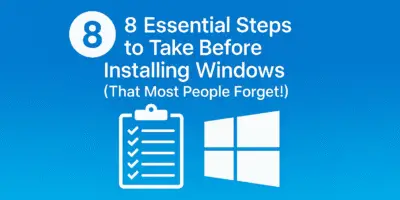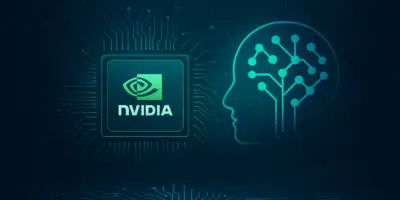Let’s be real here. When most of us hear the word “hacking,” we immediately picture someone in a dark hoodie, face hidden behind a Guy Fawkes mask, furiously typing away as they break into servers and computers with seemingly magical ease. But how does this actually happen? How can hackers gain control of devices, access cameras, steal files, and even capture passwords so effortlessly? And why do compromised devices end up for sale on black markets?
Table of Contents
- The Evolution of Hacking Knowledge
- Understanding Operating Systems: The Basics
- The Connection Between Hardware and Software
- The Security Dilemma
- The Issue with “Free” Software
- Types of Windows Systems
- 32-bit vs. 64-bit Systems
- How Computers Communicate (and How This Can Be Exploited)
- The Vulnerability of the SAM File
- User Accounts and Permissions
- Everything Is Tracked
- How Malware Persists
- The Golden Rule of Security
- How to Protect Yourself
The Evolution of Hacking Knowledge
Back in the day, when I first became interested in computer security, learning resources were pretty basic. You’d typically find a CD titled something like “Hacking from Zero to Pro” with a collection of dubious tutorials. Those CDs would contain sections on “device hacking,” “booby-trapping,” “port scanning,” “creating viruses,” and more.
Looking back, it’s embarrassing to admit, but most of that information was complete garbage with no technical foundation whatsoever. The shocking part? Some people today are still learning from these outdated and misleading resources, believing they represent legitimate cybersecurity knowledge.
But I’ll give credit where it’s due – there was one genuinely valuable piece of advice that still holds true: “Before learning to hack, learn to protect.” This wasn’t because the forum participants were ethical security experts, but rather because most of the “hacking tools” they promoted were actually malware-infested programs that would compromise the very person trying to use them. Talk about irony! You’d download a tool to hack others only to find yourself hacked instead.
As they say, the best offense is a good defense. So let’s dive deeper into understanding Windows operating systems and how they can be compromised with just a single click.
Understanding Operating Systems: The Basics
What exactly is a computer or server? Any computing device essentially consists of two components:
- Hardware – The physical components you can touch, like RAM modules, processors, graphics cards, motherboards, and hard drives.
- Software – Programs that control the hardware, with the most important being the operating system.
Hardware alone can’t function without an operating system to control it. The most popular operating system worldwide is Windows, but it’s not the only option (there’s also Linux, which we’ll mention later).
Most of us have used multiple Windows versions over the years – from Windows XP to Windows 7, 8, 10, and now 11. Microsoft doesn’t just make the Windows OS you’re familiar with; they also create related technologies like Azure Active Directory, PowerShell, Office, and Hyper-V for virtualization.
Don’t worry if these terms sound confusing right now. The important thing to understand is that we’re talking about software that’s used globally, and discovering a zero-day vulnerability in any of them could lead to serious consequences. This has happened before, with devastating results.
The Connection Between Hardware and Software
At its core, an operating system is massive software that connects hardware to users. When you want to display text on your screen or add two numbers, the OS takes your command, sends it to the hardware for processing, and returns the result to your screen.
Think of the operating system as an intelligent mediator that makes your computer understand you. Otherwise, it would just be a hunk of metal.
One crucial thing to know about Windows: it’s neither free nor open-source. Its code is owned by Microsoft and isn’t available for users to modify. Despite these limitations, Windows has two significant advantages:
- Microsoft’s extensive technical support
- Vast compatibility with almost all software we use daily, whether for gaming, studying, video editing, or work
You’ll find software for Windows that you simply can’t run on other systems like Mac or Linux. Most Windows programs have the extension “.exe”, but this convenience comes at a price.
The Security Dilemma
One of Windows’ biggest issues is its vulnerability to hacking. When Microsoft designed Windows, the priority wasn’t security but user-friendliness. And there’s a cybersecurity truism: the easier something is to use, the easier it typically is to hack.
Being the world’s most popular operating system (seriously, step back and think about that for a second) makes Windows the primary target for hackers and malware creators. If you develop malware that can infiltrate Windows systems, you’ve potentially gained access to over 70% of computers worldwide. The remaining percentage is split between Linux and Mac.
If you’re currently using Windows without Windows Defender activated (the only built-in protection system), there’s a good chance your computer is already compromised—especially if you’ve ever downloaded software from untrustworthy sources.
The Issue with “Free” Software
Remember those would-be hackers downloading tools to break into other people’s computers? Well, if hacking tools themselves contain viruses, imagine how infected regular “free” software can be!
Microsoft hasn’t ignored these threats. You have Windows Defender to protect against viruses, Windows Firewall to control incoming and outgoing connections, and BitLocker to encrypt your hard drive (preventing someone from stealing your physical drive and accessing your files). Plus, there are regular security updates to patch vulnerabilities that hackers might exploit.
Types of Windows Systems
Microsoft produces two main types of operating systems:
- Windows Client – The regular consumer version we use on our personal computers
- Windows Server – Designed to run 24/7 to provide specific services, like hosting government websites
It’s crucial that your Windows version is still supported by Microsoft under what they call “mainstream support.” If you’re using an outdated version like Windows 7, and a serious vulnerability is discovered, Microsoft won’t provide an update because they’ve discontinued support for that system. Getting security patches at that point becomes extremely expensive.
Believe it or not, many critical institutions—including hospitals, military systems, radar installations, and airports—still use outdated software because they can’t afford to shut down their systems for 24 hours to install updates. These systems have been operating for decades, and the risk of upgrading is too high.
32-bit vs. 64-bit Systems
Windows comes in two versions: 32-bit and 64-bit. The 32-bit version was designed for older computers with limited RAM (up to 4GB). If your computer has 8GB of RAM but runs a 32-bit operating system, it can only use 4GB maximum, regardless of how much RAM is physically installed.
That’s why newer systems use 64-bit architecture, which can utilize as much RAM as you install. Windows Server 2008 was the last Microsoft operating system released with a 32-bit option; everything after that is 64-bit only.
How Computers Communicate (and How This Can Be Exploited)
If you have multiple Windows computers at home—say a desktop and two laptops—each one operates independently, even if they’re all connected to the same network. Each device is responsible for itself.
For example, if you have an account named “Ahmed” with its own password on one laptop, you can’t use those same credentials to log into the other devices, even if Ahmed has admin privileges. Each computer is isolated because there’s no central system managing them all.
You could put them all under the same “workgroup” name (like “HOME”), but they’d still function independently because each computer has its own local database containing user information and passwords.
Each account has what’s called a Security ID (SID)—a unique number assigned to every user, group, or computer. Windows identifies users by these SIDs, not by usernames. If you change your username from “Ahmed” to “Adam,” the system still recognizes you as the same user with the same permissions because it’s tracking your SID.
The Vulnerability of the SAM File
All these passwords are stored in something called the SAM file. This file is extremely sensitive because if a hacker compromises your computer and extracts this file, they potentially have access to all your usernames and passwords.
The passwords are encrypted using something called a “hash,” which we’ll explain in a future post. We’ll also cover how these hashes are created, how passwords are stored, and how hackers can crack them.
For now, understand that each computer is separate from others—following the principle of “don’t put all your eggs in one basket.” If one computer in your home gets hacked, only that specific machine is compromised, not any others (assuming there’s nothing connecting them together).
User Accounts and Permissions
Each Windows computer has different account types with varying permission levels:
- Guest Account – The lowest level of permissions
- Standard User Account – Your everyday user account
- Administrator Account – Highest level of permissions on your computer
Windows controls these permissions through two main systems:
- User Access Control (UAC) – Determines what you can and cannot do (like changing wallpaper, modifying date/time, or accessing command prompt)
- Permissions – Controls read, write, and execute privileges for files and programs
These might seem like minor details, but I’ve seen companies completely compromised because a single file had incorrect permissions. Something this small can cause enormous damage.
Everything Is Tracked
Every action on your computer—plugging in a USB drive, opening or closing files, creating documents—generates an event ID that logs exactly what happened. This is crucial for digital forensics, helping investigators determine how hackers breached systems and what they did afterward.
How Malware Persists
Windows is an ocean of complexity. If I wanted to create malware to hack your system, I’d focus on services that run automatically. When you start your computer, certain programs launch automatically. If I create a virus, I’d want it to start whenever you boot your device.
Even if you discover it and kill it in Task Manager, it would restart the next time you turn on your computer. I could also create scheduled tasks to run my malware every hour or minute, so even if you terminate it, it would relaunch at the scheduled time.
Windows malware typically comes in three formats:
- .exe files (executables)
- .dll files (dynamic link libraries)
- Scripts
These are the languages Windows understands. If you have additional software like Microsoft Office installed, I could create malware in other formats too, like Word documents containing malicious macros. This is actually one of the most common ways companies get hacked today.
Why? Because I know that about 90% of companies use Microsoft Office. If I send malware that can be opened by Word, Excel, or PowerPoint, there’s a high probability that an employee will be able to open and activate it.
The Golden Rule of Security
Here’s a rule to live by: The more software you install, the easier it is to hack your device. People with numerous programs on their computers or phones are much more vulnerable to attacks.
How to Protect Yourself
My personal recommendations:
- Download software only from official sources – Get Microsoft products from Microsoft, Adobe products from Adobe, etc.
- Activate Windows Defender – Yes, it can be annoying sometimes, but it’s the free solution available to you
- Keep your system updated – Don’t postpone those updates
- Never click on untrusted links – Soon I’ll show you how devices can be compromised with a single click, or even with no clicks at all
- Use strong protection software if your work involves sensitive data
As a Windows user, you need to stay informed and vigilant. Don’t invite viruses into your home yourself. The system isn’t inherently weak, but hackers don’t mess around. The difference between an average user and a smart one is simply basic security awareness, which I’ve tried to provide in this post.


